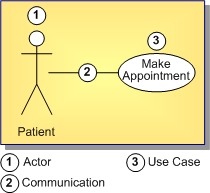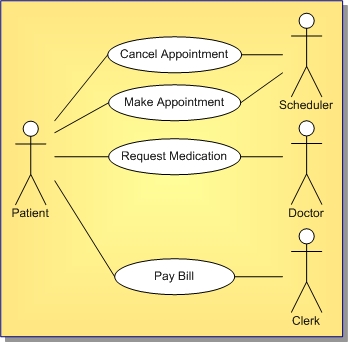Use case diagrams are helpful in three areas:
Use Case Diagrams describe what a system does from the viewpoint of an external observer. The emphasis is on what a system does rather than how.
Use Case Diagrams are closely connected to scenarios. A scenario is an example of what happens when someone interacts with the system.
Following is a scenario for a medical clinic:
A patient calls the clinic to make an appointment for a yearly checkup. The receptionist finds the nearest empty time slot in the appointment book and schedules the appointment for that time slot.
A use case is a summary of scenarios for a single task or goal. An actor is who or what initiates the events involved in that task. Actors are simply roles that people or objects play. The following diagram is the Make Appointment use case for the medical clinic. The actor is a Patient. The connection between actor and use case is a communication association (or communication for short).

Actors are stick figures. Use cases are ovals. Communications are lines that link actors to use cases.
A use case diagram is a collection of actors, use cases, and their communications. Following is an example of the use case Make Appointment as part of a diagram with four actors and four use cases. Notice that a single use case can have multiple actors.

|
Copyright(C) 2009 Embarcadero Technologies, Inc. All Rights Reserved.
|
|
What do you think about this topic? Send feedback!
|